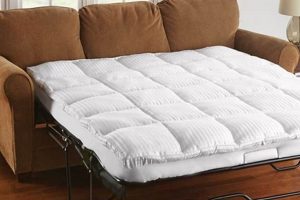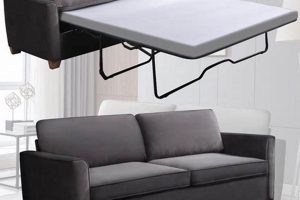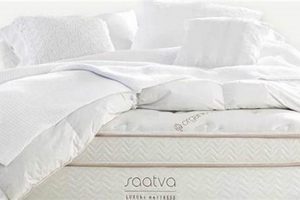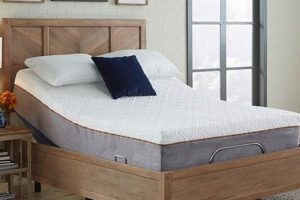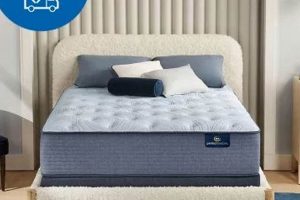A sleeping arrangement involving a thin, often portable, pad placed directly on the ground defines this practice. Commonly constructed from materials like foam, cotton, or futon filling, these surfaces provide a minimalist alternative to traditional bed frames. Their use can be observed in diverse settings, from temporary guest accommodations to permanent fixtures in minimalist living spaces.
Adopting this sleeping style is sometimes motivated by perceived health benefits, such as improved spinal alignment and reduced back pain. Historically, sleeping close to the earth has been a common practice in various cultures, dictated by resource availability and nomadic lifestyles. Advocates suggest that the firmer surface promotes better posture and deeper sleep, while others appreciate the space-saving aspect and cost-effectiveness.
The following sections will delve into a detailed examination of various aspects related to this practice, encompassing its potential advantages and disadvantages, suitable mattress types, considerations for different demographics, and practical guidance on incorporating this method into one’s lifestyle. Furthermore, we will analyze its effect on spine and posture. The discussion will conclude with an overview of pertinent research and expert opinions.
Guidance for Floor-Level Sleeping Arrangements
The following recommendations aim to optimize the experience of sleeping on a ground-level mattress, addressing considerations for comfort, hygiene, and potential drawbacks.
Tip 1: Select an Appropriate Mattress Thickness: A mattress intended for floor use should possess sufficient thickness to provide adequate cushioning and support. A minimum of four inches is generally recommended, with thicker options providing enhanced comfort and insulation from the cold floor.
Tip 2: Employ a Moisture Barrier: Direct contact with the floor can lead to moisture accumulation and potential mold growth. Place a waterproof or moisture-wicking barrier between the mattress and the floor to mitigate this risk and prolong the mattress’s lifespan.
Tip 3: Ensure Adequate Ventilation: Regularly lift the mattress to allow air circulation underneath. This practice helps to prevent moisture buildup and inhibit the growth of mold and mildew. Schedule regular airing sessions, ideally weekly, especially in humid environments.
Tip 4: Choose a Supportive Mattress Material: Materials like memory foam or latex offer superior support and pressure relief compared to traditional innerspring mattresses when used on the floor. Consider these options to maximize comfort and minimize potential back pain.
Tip 5: Prioritize Proper Spinal Alignment: While some proponents suggest floor sleeping improves spinal health, incorrect posture can exacerbate existing issues. Maintain a neutral spine position by selecting a mattress that conforms to the body’s natural curves. Consult a healthcare professional if experiencing persistent discomfort.
Tip 6: Maintain Cleanliness: Regularly vacuum the floor area beneath the mattress and launder bedding frequently. This minimizes dust mite populations and promotes a hygienic sleeping environment.
These measures serve to enhance the comfort and safety of using ground-level mattresses, helping to mitigate potential problems. This practice necessitates awareness of hygiene, ventilation, and support.
The next segment will explore the specific considerations for individuals with pre-existing health conditions and discuss the suitability of this sleeping arrangement for diverse populations.
1. Firmness and Support
The characteristics of firmness and support are pivotal when employing a mattress directly on the floor. A lack of adequate firmness can result in spinal misalignment, potentially exacerbating pre-existing back conditions or contributing to new musculoskeletal discomfort. Conversely, insufficient support can lead to pressure points and restless sleep. A ground-level placement lacks the give of a bed frame or box spring, demanding that the mattress itself provide all necessary structural integrity. This necessitates careful consideration of mattress composition and density.
For instance, a very soft memory foam mattress, while comfortable atop a bed frame, may compress excessively on a hard floor surface, failing to offer sufficient support for the lower back. In this scenario, the individual may experience lower back pain and discomfort upon waking. Alternatively, a high-density latex mattress of appropriate thickness will provide both firmness and support, maintaining spinal alignment and distributing weight evenly. An appropriate selection mitigates the risks associated with improper weight distribution and structural instability.
In conclusion, the selection of a mattress for floor use must prioritize firmness and support to ensure proper spinal alignment and weight distribution. Understanding the relationship between these elements and their impact on posture and sleep quality is crucial for maximizing the benefits and minimizing the potential drawbacks of sleeping in such an arrangement. The mattress’s ability to provide both support and conformity is key to mitigating common complaints of this sleep practice.
2. Hygienic Practices
The practice of placing a sleep surface directly on the floor necessitates a heightened awareness of hygienic practices. Direct contact with the floor introduces several potential vectors for contamination, including dust mites, allergens, mold spores, and bacteria. Unlike a bed frame, which elevates the mattress and allows for air circulation, a floor-level arrangement traps moisture and restricts ventilation, creating a conducive environment for microbial growth. Failure to implement rigorous cleaning protocols can result in respiratory issues, skin irritations, and a compromised sleep environment. For instance, a poorly ventilated mattress left directly on a carpeted floor may quickly accumulate moisture, leading to the proliferation of mold, particularly in humid climates, and exposing the sleeper to harmful airborne particles.
Effective mitigation strategies involve several key components. Regular vacuuming of the floor area beneath the mattress is essential for removing dust mites and other allergens. The use of a breathable mattress protector acts as a barrier against moisture and spills, safeguarding the mattress core. Periodic lifting of the mattress to allow for air circulation prevents moisture buildup and inhibits microbial growth. Furthermore, the selection of mattress materials plays a crucial role; natural, breathable materials such as latex or organic cotton are preferable to synthetic materials that trap moisture and promote bacterial growth. These practices can substantially decrease the risk of health complications associated with floor-level sleeping.
In summary, the intersection of hygienic practices and the use of a ground-level sleep surface underscores the critical importance of meticulous cleaning and preventative measures. Neglecting these considerations can lead to a cascade of negative health outcomes, undermining any potential benefits associated with this sleeping arrangement. Prioritizing ventilation, moisture control, and regular cleaning protocols is essential for maintaining a safe and healthy sleep environment when utilizing a mattress placed directly on the floor. The long-term viability of this practice hinges on consistently applied hygienic principles.
3. Ventilation Needs
Placing a mattress directly on the floor significantly impedes airflow, creating a microclimate susceptible to moisture accumulation. This lack of ventilation forms a direct causal link to several undesirable consequences. Condensed moisture can foster the growth of mold and mildew within the mattress and on the floor surface, potentially triggering allergic reactions and respiratory problems. Furthermore, trapped moisture contributes to the degradation of mattress materials, shortening its lifespan and compromising its structural integrity. The importance of adequate ventilation as a component of this sleep arrangement cannot be overstated. Without proper airflow, the environment surrounding the mattress becomes unhygienic, uncomfortable, and potentially hazardous to health.
Consider the example of a memory foam mattress placed on a concrete floor in a basement environment. Concrete inherently retains moisture, and memory foam, being relatively non-breathable, exacerbates the problem. Without ventilation, moisture will gradually accumulate within the mattress, leading to the growth of mold and the release of unpleasant odors. This scenario illustrates the practical significance of understanding the relationship between ventilation and mattress placement. Mitigation strategies include the use of a slatted platform to elevate the mattress, regular airing of the mattress, and the selection of breathable mattress materials, such as latex or natural fibers. These measures promote airflow and reduce the risk of moisture-related problems.
In summary, the connection between ventilation needs and the practice of using a floor mattress is a critical consideration for maintaining a healthy and comfortable sleep environment. Inadequate ventilation leads to moisture accumulation, mold growth, and material degradation. Addressing this issue through proactive measures, such as elevating the mattress and selecting breathable materials, is essential for mitigating potential health risks and ensuring the longevity of the mattress. Overlooking these ventilation considerations compromises the safety and hygiene of this sleeping arrangement.
4. Spinal Alignment
Maintaining proper spinal alignment during sleep is paramount for overall musculoskeletal health. The relationship between sleep posture and spinal health is particularly relevant when considering the use of a mattress placed directly on the floor. This setup presents unique challenges and opportunities for achieving and maintaining optimal spinal positioning throughout the night.
- Mattress Firmness and Curvature Support
The degree of firmness provided by the sleep surface directly influences spinal alignment. A surface that is too soft may allow the spine to sag, leading to misalignment and potential back pain. Conversely, a surface that is too firm may not adequately conform to the body’s natural curves, resulting in pressure points and discomfort. When sleeping on a floor mattress, selecting a firmness level that supports the spine’s natural curves particularly the lumbar region is critical for preventing misalignment.
- Sleeping Position and Postural Adaptation
Different sleeping positions place varying degrees of stress on the spine. Side sleeping, for instance, generally requires a thicker mattress to maintain spinal alignment, while back sleeping benefits from a flatter, more supportive surface. When using a floor mattress, individuals must carefully consider their preferred sleep position and select a mattress that accommodates the corresponding postural needs. Adjusting pillow height can further optimize spinal alignment based on the chosen sleeping position.
- Muscle Relaxation and Reduced Compression
Proper spinal alignment facilitates muscle relaxation and reduces compression of intervertebral discs. Misalignment, on the other hand, can lead to muscle strain and increased disc pressure, potentially contributing to chronic back pain. A well-chosen floor mattress, combined with appropriate sleep posture, can promote spinal decompression and muscle relaxation, fostering a more restful and restorative sleep experience.
- Long-Term Spinal Health Considerations
Sustained misalignment during sleep can have long-term consequences for spinal health, potentially contributing to degenerative disc disease, nerve impingement, and other musculoskeletal problems. While anecdotal evidence suggests that sleeping on a floor mattress can improve spinal alignment for some individuals, rigorous scientific evidence is lacking. Individuals with pre-existing spinal conditions should consult with a healthcare professional before adopting this sleep arrangement to ensure that it is appropriate for their specific needs.
Achieving optimal spinal alignment when sleeping on a mattress placed directly on the floor requires careful attention to mattress firmness, sleep position, and individual spinal health considerations. While this sleep arrangement may offer potential benefits for some, it is essential to prioritize proper spinal support and consult with a healthcare professional to address any concerns or pre-existing conditions. Ultimately, the suitability of this practice depends on a holistic understanding of its impact on spinal biomechanics and individual health needs.
5. Suitable Materials
The selection of appropriate materials is a critical determinant of the comfort, hygiene, and longevity of a mattress intended for direct floor placement. Unlike traditional bed setups, a floor mattress lacks the support and ventilation provided by a bed frame, placing greater demands on the inherent qualities of its constituent materials. The choice of materials directly impacts moisture management, temperature regulation, support, and resistance to microbial growth. For example, a mattress constructed from non-breathable synthetic materials, such as low-density polyurethane foam, will trap moisture against the floor, fostering mold and mildew growth and creating an unsanitary sleeping environment. Conversely, a mattress employing breathable natural materials, such as latex or organic cotton, will promote air circulation and mitigate moisture accumulation, enhancing hygiene and extending the mattress’s lifespan.
Practical applications of this understanding are evident in the design and construction of specialized floor mattresses. Traditional Japanese futons, for instance, often incorporate layers of cotton batting and a breathable outer cover, allowing for efficient moisture wicking and temperature regulation. Similarly, modern floor mattresses may utilize open-cell memory foam or latex cores, which provide both support and enhanced airflow compared to conventional memory foam. The selection of a suitable material also depends on the intended use of the mattress. A temporary guest mattress may prioritize portability and affordability, leading to the selection of less durable materials. In contrast, a permanent floor mattress intended for long-term use requires a more robust construction and higher-quality materials to ensure adequate support and longevity. These practical considerations underscore the direct link between material selection and the overall success of a floor-sleeping arrangement.
In summary, the suitability of materials for a floor mattress directly influences its performance and lifespan. Prioritizing breathable, moisture-wicking materials is essential for maintaining hygiene and preventing the growth of mold and mildew. The selection should also consider the intended use of the mattress and the desired level of support and durability. While cost may be a factor, investing in higher-quality materials ultimately contributes to a healthier and more comfortable sleeping experience. The inherent characteristics of the materials used are paramount to the success of this sleep style.
6. Temperature Control
Maintaining a comfortable sleep environment is crucial for restorative rest, and temperature regulation becomes particularly significant when a mattress is placed directly on the floor. Proximity to the ground can exacerbate temperature fluctuations, leading to either excessive cooling or heat retention, depending on the floor material and ambient conditions. Understanding and managing these factors is paramount for optimizing sleep quality in this context.
- Floor Material Conductivity
The thermal conductivity of the floor surface directly impacts heat transfer. Concrete or tile floors, possessing high thermal conductivity, readily draw heat away from the body, potentially leading to a sensation of coldness, especially during colder months. Conversely, carpeted floors offer insulation, trapping heat and potentially causing overheating. Selecting appropriate bedding materials and considering the floor’s thermal properties is crucial for mitigating these effects. For example, using a thick wool blanket on a concrete floor can offset the heat loss, while lighter, breathable fabrics are more suitable for carpeted surfaces.
- Ambient Air Circulation
Adequate air circulation is essential for dissipating body heat and preventing overheating. When a mattress is placed directly on the floor, airflow is often restricted, particularly underneath the mattress. This can lead to a buildup of heat and moisture, creating an uncomfortable and potentially unhygienic sleep environment. Strategies to improve air circulation include elevating the mattress slightly using a slatted platform or regularly airing the mattress to promote ventilation. Open windows or the use of fans can also enhance airflow within the room.
- Mattress Material Properties
The materials composing the mattress significantly influence temperature regulation. Dense materials, such as memory foam, tend to retain heat, while more breathable materials, like latex or natural fibers, allow for better air circulation and heat dissipation. Selecting a mattress constructed from breathable materials is particularly important for individuals prone to overheating or those living in warmer climates. Furthermore, the use of moisture-wicking bedding can help to regulate body temperature by drawing away perspiration and preventing discomfort caused by dampness.
- Seasonal Considerations
Temperature control strategies must adapt to seasonal variations. During colder months, insulation becomes a primary concern. Utilizing thicker blankets, placing a rug beneath the mattress, and ensuring adequate heating within the room can help to maintain a comfortable sleeping temperature. Conversely, during warmer months, ventilation and breathable bedding are crucial for preventing overheating. Opening windows, using fans, and selecting lightweight, moisture-wicking fabrics can promote cooling and prevent discomfort caused by excessive heat.
Addressing temperature control in conjunction with a floor mattress necessitates a comprehensive approach that considers floor material, air circulation, mattress composition, and seasonal variations. By carefully managing these factors, individuals can create a comfortable and restorative sleep environment, mitigating the potential drawbacks associated with floor-level sleeping. Failure to address temperature regulation can lead to discomfort, disrupted sleep, and potentially adverse health effects, highlighting the importance of proactive management in this context. The balance of insulation and ventilation is crucial to thermal comfort.
Frequently Asked Questions Regarding Ground-Level Mattresses
The following addresses common inquiries and misconceptions regarding the practice of sleeping on a mattress placed directly on the floor. The information aims to provide clarity and informed guidance for individuals considering this sleeping arrangement.
Question 1: Is placing a mattress directly on the floor detrimental to one’s health?
The health impact depends on several factors, including hygiene, ventilation, and individual physical condition. Proper maintenance, including regular cleaning and adequate airflow, can mitigate potential risks. Individuals with pre-existing respiratory conditions or allergies should consult with a healthcare professional.
Question 2: What type of mattress is most suitable for floor placement?
Mattresses constructed from breathable materials, such as latex or open-cell memory foam, are generally recommended due to their enhanced ventilation properties. Sufficient thickness is also crucial to provide adequate support and insulation from the cold floor.
Question 3: How can mold growth be prevented when using a floor mattress?
Preventive measures include using a moisture barrier between the mattress and the floor, regularly airing the mattress to promote ventilation, and maintaining a clean and dry environment. Dehumidifiers can also be beneficial in humid climates.
Question 4: Does sleeping on a floor mattress improve spinal alignment?
While anecdotal evidence suggests potential benefits for some individuals, scientific evidence is limited. A firm mattress that provides adequate support can contribute to proper spinal alignment. However, individual results may vary, and consultation with a healthcare professional is advised.
Question 5: Is sleeping on a floor mattress suitable for all ages?
The suitability of this sleeping arrangement varies depending on age and physical condition. Infants and young children should not sleep on floor mattresses due to potential safety hazards. Elderly individuals or those with mobility issues may find it difficult to get up from a floor mattress.
Question 6: How often should a floor mattress be cleaned?
Regular cleaning is essential to maintain hygiene. The floor area beneath the mattress should be vacuumed at least weekly. The mattress itself should be aired out and, if possible, cleaned with a mild detergent solution every few months.
In summary, using a ground-level mattress requires careful consideration of various factors to ensure a safe and healthy sleep environment. Prioritizing hygiene, ventilation, and proper mattress selection is crucial for mitigating potential risks.
The following section will provide specific product recommendations, categorized by budget and intended use case.
Conclusion
The practice of sleep on the floor mattress presents a confluence of advantages and disadvantages that necessitate careful evaluation. As this exploration has demonstrated, the viability of this sleeping arrangement hinges upon meticulous attention to factors such as mattress selection, hygiene maintenance, ventilation strategies, and individual health considerations. While purported benefits may include improved spinal alignment and cost-effectiveness, these advantages are contingent upon diligent implementation of best practices and a thorough understanding of potential drawbacks.
Ultimately, the decision to engage in sleep on the floor mattress should be predicated on a comprehensive assessment of personal needs, lifestyle constraints, and a commitment to maintaining a clean and supportive sleep environment. Further research into the long-term effects of this practice is warranted. Individuals contemplating this arrangement are strongly encouraged to consult with healthcare professionals to determine its suitability for their specific circumstances. The future of sleep and mattresses might incorporate this lifestyle.


